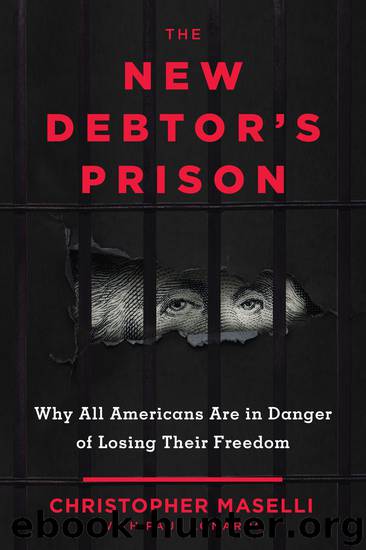The New Debtors' Prison by Christopher B. Maselli

Author:Christopher B. Maselli
Language: eng
Format: epub
ISBN: 9781510733268
Publisher: Skyhorse
Published: 2019-03-19T16:00:00+00:00
BIG BUSINESS
The American prison system is massive. So massive, in fact, that its estimated turnover of $74 billion eclipses the GDP of 133 nations.18 There are more prisoners than farmers in the US, with many prisons now in rural areas where farms once were.19 Many American towns, once dependent on farming, mining, and manufacturing, are now wholly dependent on a prison. Another unsettling fact is that it is the American taxpayer who get billed, and we are all helping to pad the pockets of publicly traded corporations like Corrections Corporation of America (CCA) and GEO Group, which provides correctional and community reentry services. Combined, both of these companies generated over $2.53 billion in revenue in 2012 and represent more than half of the private prison business.20
So what exactly makes the business of incarcerating Americans so lucrative? The average cost of incarcerating an American prisoner varies from state to state. Some states, like Indiana, have managed to keep prices low at around $14,000 per inmate, while states like New York pay around $60,000 apiece to keep their citizens behind bars. According to a 2012 Vera Institute of Justice study, the number of those incarcerated has increased by over 700 percent over the last four decades, with the cost to the taxpayer of exceeding $39 billion.21
Without question, that cost burden is staggering, and it begs the logical question; what is all that taxpayer money being spent on?
The breakdown appears standard enough, with the Vera Institute contending that many corrections-related costs, such as employee benefits and taxes, pension contributions, retiree health care contributions, legal judgments, and claims, are deemed central administrative costs. Moreover, many states fund inmate services—such as hospital care in eight states, and education and training in 12 states—outside of their corrections departments. It’s a nice accounting trick, but this amounts to a $5.5 billion gap between the reported corrections budgets of the forty states examined by the study—$33.5 billion—and the actual cost to the taxpayer of $39 billion.22
What this points to is the continued privatization of the prison industry. Competition in any work environment is, in theory, a good thing that should lead to lower costs across the board. The debate rages on regarding who can do a better job: the bureaucracy or private companies? Does it matter, or is it just about cost cutting? An interesting question, because privatization would save taxpayers a boatload of money in the renovation and building of new facilities, not to mention all the prison personnel to whom citizens would have to pay salaries and pensions in perpetuity.
Today, privatized prisons make up over 10 percent of the corrections market. Private prisons like CCA not only provide states and the federal government with lower “per-diem” costs, but they also provide a means for them to balance their budgets by buying off and refurbishing state-owned prisons. CCA operates the fifth-largest prison system, public or private, in the system in the US. Under its control are fifty-one owned-and-operated facilities in sixteen states and contracted management of eighteen more state-owned facilities in seven states.
Download
This site does not store any files on its server. We only index and link to content provided by other sites. Please contact the content providers to delete copyright contents if any and email us, we'll remove relevant links or contents immediately.
International Integration of the Brazilian Economy by Elias C. Grivoyannis(75471)
The Radium Girls by Kate Moore(11626)
Turbulence by E. J. Noyes(7707)
Nudge - Improving Decisions about Health, Wealth, and Happiness by Thaler Sunstein(7250)
The Black Swan by Nassim Nicholas Taleb(6773)
Rich Dad Poor Dad by Robert T. Kiyosaki(6185)
Pioneering Portfolio Management by David F. Swensen(6083)
Man-made Catastrophes and Risk Information Concealment by Dmitry Chernov & Didier Sornette(5658)
Zero to One by Peter Thiel(5498)
Secrecy World by Jake Bernstein(4393)
Millionaire: The Philanderer, Gambler, and Duelist Who Invented Modern Finance by Janet Gleeson(4106)
The Age of Surveillance Capitalism by Shoshana Zuboff(3991)
Skin in the Game by Nassim Nicholas Taleb(3973)
The Money Culture by Michael Lewis(3851)
Bullshit Jobs by David Graeber(3837)
Skin in the Game: Hidden Asymmetries in Daily Life by Nassim Nicholas Taleb(3731)
The Dhandho Investor by Mohnish Pabrai(3564)
The Wisdom of Finance by Mihir Desai(3529)
Blockchain Basics by Daniel Drescher(3332)
